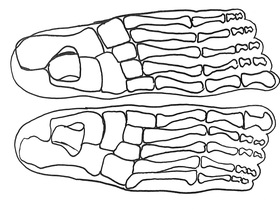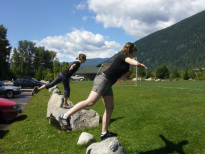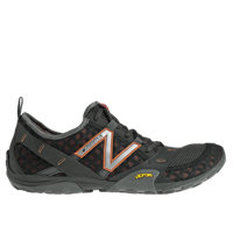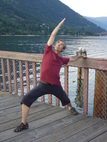
In a previous article on 'barefooting' I mentioned that my experience with increased use and resulting 'foot exercise' has changed the shape, strength, size as well as arches of my feet, I sense in a corrective way from being primarily shod most of my life. While standing, our pelvis/pelvic girdles, legs and feet can be perhaps thought of as the 'guided' foundation of our evolved upright postural position and movement, which is a big deal really although taken for granted. Intelligent and appropriate barefooting in my experience can help to recreate a wider/happier 'toe' area, especially across the metatarsal area. Along with shifting the weight-bearing focus more to the ball of my foot with increased 'spring' and strength as well as widening the base of this area of the foot has proved to enhance my upright balance...playful self help ; )
Posture, as a functional position and movement relates more broadly to our body image, sensory (kinesthetic) awareness, structural control, stability, alignment, balance and mobility in space (use). Postural evaluation I believe would benefit from a more systems/holistic view than the single common upright position generally measured regarding healthy use. One such systems approach evolved years ago by Dr. Robert Manatt Martin MD who suggested six basic 'human' postures or functional bodily movements in two categories.
The first common postural group produces compression and shortening of stature and the second uncommon posture group produces the opposite forces, those of elongation or decompression. The six positions: standing, lying down, forward bending, back bending, inversion (eg. hand stand) and brachiation (eg. hanging by our upper limbs), which in my view represents a more complete and useful picture of our postural health and ability. He relates: "...how the uncommon postures, when properly employed, will counter and correct the damaging effects produced in the body by gravity from exclusive use of the common (compressive) postures." In other words, it seems it may be beneficial to get down n' active and up and fully engaged like the playful beings that we can be. Playful yoga class anyone?
In terms of positioning of the pelvis in 'space', my view or 'normal' in the last few years from mat work, reading and an n=1 case study has changed some/evolved. From the more vertical positioning of the pelvis that I 'learned' from anatomy labs and classes as well as movement teacher training I now prefer a more natural or ancestral position where my pelvic 'bowl' is gently tilted forward (or same as sticking my butt out a bit ; ). I feel this positional shift of the pelvis along with changes to my feet has helped to promote a stronger and healthier functional posture, especially sitting and standing. These changes have also included a breathing pattern improvement- more freedom for natural abdominal (diaphragm activated) and thoracic breathing which I feel has promoted a more relaxed yet alert state of embodiment (so...good for someone like me more prone to anxiety;).
Esther Gokhale refers to this pelvic angle as the "anteverted position" of the pelvis. Philip Pawley, a knowledgeable Alexander Method practitioner recommends 'sticking out our butt when seated' for genuine good posture SmilingBackMethod site.
Also helpful for upright posture is imagining a link between the lower ribs/navel and tail bone (which helps 'constrain' the arching of the spine and opening upwards of the ribs), an active and vital diaphragm muscle, the feeling/visualization of a strong upright spinal column, an 'open' heart/chest topped with 'wide' relaxed shoulders with the scapula (shoulder blades) located or moving 'neighbourly' with the back rib cage area.
I'll finish this post by leaving you with three upright standing posture suggestions/understandings:
Feet: for most of us shod folks it would assist our upright standing and walking posture well by naturally widening the area of the foot at the base of the toes through barefoot use (foot exercise; ) and/or using toe spacer exercises or products.
Pelvis: when standing or sitting many would benefit from a more natural 'slightly tilted anteriorly' pelvic position, again more along the lines of 'allowing your butt to stick out some'. Also remember to use well your 'core' support through the transverse abdominal girdle and accompanying back muscles, particularly the erector spinae muscle group and by the imaginary diagonal line between your anterior lower rib cage and tail bone.
Chest and Shoulders: healthy shoulder/arm and chest position in my view is way enhanced by strengthening movements and functional use such as Dr. Martin recommended (he was an accomplished gymnast); so a variety of postural positions (or variations that you can manage ;) such as arm balancing (inversion) and weighted pulling like pull ups/chin ups or pushing like push ups can be of benefit. Mostly, we would benefit from functionally strengthening up our upper back; it's a benefit in my view to 'seat' our shoulder blades to our back rib cage area. This supports a more open chest and I would add a more open heart and 'human' presence. Soo... shoulder girdles stable yet relaxed ; )
Intention, Attention and Awareness as a bonus: Remember to pause during your day, perhaps while taking tea to centre and realign through these inner 'sensibilities'. These 'meditative moments' can be a valuable 'practice' to help maintain/recreate an upright postural 'home-base' while standing or sitting during your day.
What postural tips, suggestions and understandings might you recommend to add to the conversation?
Towards living a healthy, wholesome and happy life,
Don
Posture, as a functional position and movement relates more broadly to our body image, sensory (kinesthetic) awareness, structural control, stability, alignment, balance and mobility in space (use). Postural evaluation I believe would benefit from a more systems/holistic view than the single common upright position generally measured regarding healthy use. One such systems approach evolved years ago by Dr. Robert Manatt Martin MD who suggested six basic 'human' postures or functional bodily movements in two categories.
The first common postural group produces compression and shortening of stature and the second uncommon posture group produces the opposite forces, those of elongation or decompression. The six positions: standing, lying down, forward bending, back bending, inversion (eg. hand stand) and brachiation (eg. hanging by our upper limbs), which in my view represents a more complete and useful picture of our postural health and ability. He relates: "...how the uncommon postures, when properly employed, will counter and correct the damaging effects produced in the body by gravity from exclusive use of the common (compressive) postures." In other words, it seems it may be beneficial to get down n' active and up and fully engaged like the playful beings that we can be. Playful yoga class anyone?
In terms of positioning of the pelvis in 'space', my view or 'normal' in the last few years from mat work, reading and an n=1 case study has changed some/evolved. From the more vertical positioning of the pelvis that I 'learned' from anatomy labs and classes as well as movement teacher training I now prefer a more natural or ancestral position where my pelvic 'bowl' is gently tilted forward (or same as sticking my butt out a bit ; ). I feel this positional shift of the pelvis along with changes to my feet has helped to promote a stronger and healthier functional posture, especially sitting and standing. These changes have also included a breathing pattern improvement- more freedom for natural abdominal (diaphragm activated) and thoracic breathing which I feel has promoted a more relaxed yet alert state of embodiment (so...good for someone like me more prone to anxiety;).
Esther Gokhale refers to this pelvic angle as the "anteverted position" of the pelvis. Philip Pawley, a knowledgeable Alexander Method practitioner recommends 'sticking out our butt when seated' for genuine good posture SmilingBackMethod site.
Also helpful for upright posture is imagining a link between the lower ribs/navel and tail bone (which helps 'constrain' the arching of the spine and opening upwards of the ribs), an active and vital diaphragm muscle, the feeling/visualization of a strong upright spinal column, an 'open' heart/chest topped with 'wide' relaxed shoulders with the scapula (shoulder blades) located or moving 'neighbourly' with the back rib cage area.
I'll finish this post by leaving you with three upright standing posture suggestions/understandings:
Feet: for most of us shod folks it would assist our upright standing and walking posture well by naturally widening the area of the foot at the base of the toes through barefoot use (foot exercise; ) and/or using toe spacer exercises or products.
Pelvis: when standing or sitting many would benefit from a more natural 'slightly tilted anteriorly' pelvic position, again more along the lines of 'allowing your butt to stick out some'. Also remember to use well your 'core' support through the transverse abdominal girdle and accompanying back muscles, particularly the erector spinae muscle group and by the imaginary diagonal line between your anterior lower rib cage and tail bone.
Chest and Shoulders: healthy shoulder/arm and chest position in my view is way enhanced by strengthening movements and functional use such as Dr. Martin recommended (he was an accomplished gymnast); so a variety of postural positions (or variations that you can manage ;) such as arm balancing (inversion) and weighted pulling like pull ups/chin ups or pushing like push ups can be of benefit. Mostly, we would benefit from functionally strengthening up our upper back; it's a benefit in my view to 'seat' our shoulder blades to our back rib cage area. This supports a more open chest and I would add a more open heart and 'human' presence. Soo... shoulder girdles stable yet relaxed ; )
Intention, Attention and Awareness as a bonus: Remember to pause during your day, perhaps while taking tea to centre and realign through these inner 'sensibilities'. These 'meditative moments' can be a valuable 'practice' to help maintain/recreate an upright postural 'home-base' while standing or sitting during your day.
What postural tips, suggestions and understandings might you recommend to add to the conversation?
Towards living a healthy, wholesome and happy life,
Don



 RSS Feed
RSS Feed